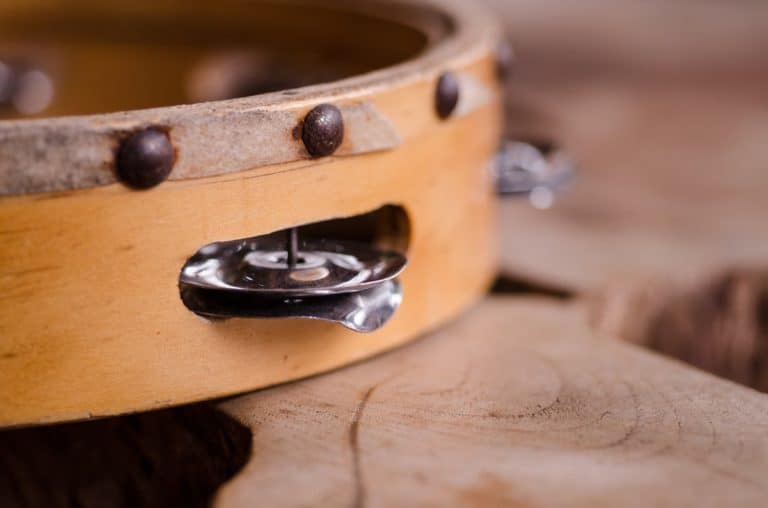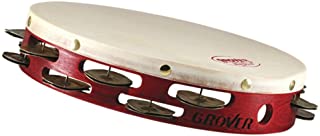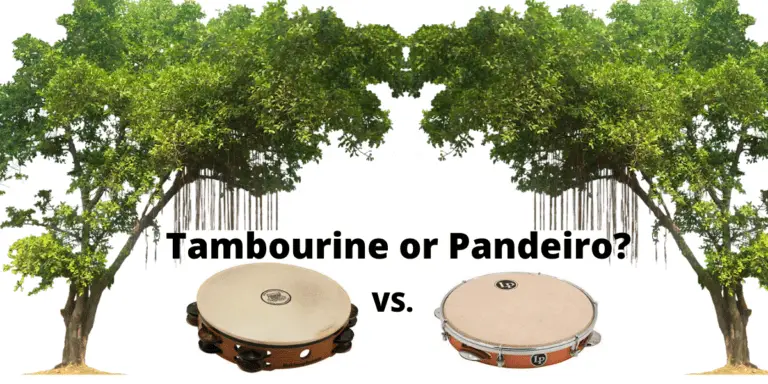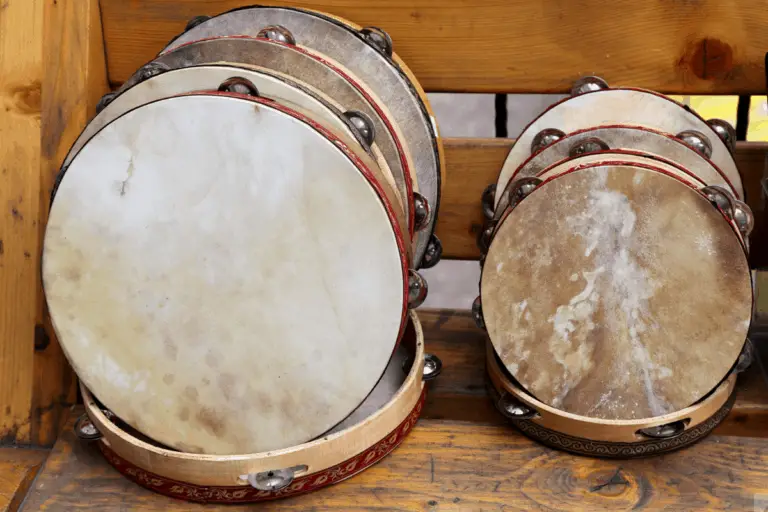Best Tambourine For Concert (Checklist and Considerations)
If you are looking to buy a high-quality symphonic tambourine for performance, you know you are going to pay. With that comes the concern of what you might get for your money and if you are getting value.
Which is the best tambourine for concert? – The Grover Pro Projection Plus with Silver/Bronze is recommended. The combination jingle model (T2/GSPH Double Row) provides better articulation and wetness for highs and lows in one instrument. Expect to pay in the region of $170-$200 for this tambourine that will last for years.
Below I go into more detail of what to look for in a concert tambourine. I also run through the benefits of tried and trusted tambourine brands. I look at the size and jingle options s well as some alternatives if Grover isn’t ticking your boxes.
My Tambourine Element Checklist
- Hardwood Rim
- 10 inch Diametre
- Double Row/Staggered Jingles
- Natural Head
What to Consider When Buying a Concert Tambourine
There are many things to consider when buying a concert tambourine. The chances are, if you are reading this, you are either looking to buy a concert tambourine for the first time, doing a little more research before making a final decision or are looking to upgrade from the current model you have.
Here are some things to consider, how to approach your research and my recommendations. There is a short section for each below
| Size | Construction | Jingles |
| Head | Accessories | Maintenance |
Selecting your perfect tambourine and being certain you are making the right choice can be hard. Each will be different from another and unique in sound, feel and performance. Let’s take a closer look.
Size
The size of the tambourine you choose will be based around the diameter. The recommended and most popular size is 10 inches. Ultimately the choice will be yours on what feels best in your hand.
The width of your tambourine does not make a great difference to the way it sounds, so do not expect higher or lower sounds by going smaller or larger. Sound is managed more by the jingle material used and how you play and to a lesser extent, the head material.
Larger 12 Inch and smaller 8-inch models will be an option and will arrive with more or fewer jingles respectively. The obvious difference apart from the number of jingles will be the weight of each tambourine too.
For me, the smaller is a little too light for control, and conversely, the wider instrument is a little heavy on my wrists. (I have very small wrists)
In fact, I will stick my neck out here and suggest the 10 inch is the right size most of the time. It is the consensus pick, feels right in my hand and the most popular size played.
Construction
A hardwood shell is absolutely preferred to synthetic material shells. both are available, but with a traditional steam-bent wooden rim, you are ensuring your instrument is based on quality.
One added element to the rim of your tambourine is where the grip is. Often overlooked, if you can find a tambourine with a tapered grip section, you will find the comfort in holding your instrument will be enhanced greatly.
The tapered grip is a small indentation right about where you hold the tambourine making that area slightly narrower
This ensures a greater time before grip fatigue sets in. If you have ever played tambourine for an extended or rigorous amount of time, you will understand what this can do and feel like in your hand grip and wrist. It is not pleasant and diminishes the enjoyment of playing. Not to mention the potentially detrimental effect of your performance.
Part of the construction process is how and where the jingles are positioned. There are two options here, either vertically stacked or staggered around the rim.
I will take a closer look at Jingles below but consider how the jingle slots are arranged and how the jingles are held in place. And whilst it may sound really obvious, also look for good clearance in the slot, so there is plenty of movement available and the jingles can not get caught up.
Look for a tambourine with captive jingle pins too. This means the pins are encased in the rim and thus the jingles can not fall out, other than in the case of a pin being broken
Jingles
Potentially the most important part of your tambourine. 90% of your performance is about the jingles. Selecting the right number, configuration and jingle material is absolutely key to what you are trying to achieve.
Single Row Jingles vs Double Row Jingles
Another choice that has to be made, on the basis that two are available is how many rows of jingles you want on your concert tambourine. With the option of single or double row, it’s one more aspect of making the right choice. In almost all cases, the double row is right, the single row can play a part but often as an additional option rather than the go-to.
Single Row Jingles
Whilst my preference is for double rows of jingles, single rows do have their place for a very specific reason. You will often hear descriptions such as ‘dry’ or ‘wet’ in relation to jingle sound. Whilst this is not solely down to the number of rows of jingles, you will be looking at a drier sound with a single row.
Double Row Jingles
Double rows are more common and offer a more lush sound. A richer depth to the resonance of the additional jingles
Staggered Jingle Slots vs Stacked Slots
I will first and foremost point out that for this article I am recommending my personal preference – don’t I always – the Double row jingles. read on to find out why.


Above you can see the different configurations. The Grover Pro (red), has staggered jingle slots as opposed to the Black Swan which has stacked jingles directly on top of each other.
Now, again, this is a purely personal choice, but my preference is for the staggered jingles and the consistent sound it produces.
Staggered jingles are more responsive when playing directly above the rim, which is natural and makes sense when you look at the respective positioning. Again, this is not a cramp on the stacked jingles, which sounds great, but for me and in general, the staggered jingles are more popular.
Jingle Material
Thought we were finished with Jingles? Not Yet!, Arguably the most important thing to consider in the jingles section is what materials you jingles are made from. And there are options!
- Bronze (Lower Pitch)
- Copper (Medium Pitch)
- Silver (Higher Pitch)
A bronze jingle tambourine is going to be great for thumb rolls and shakes, but not the best for articulation where a silver set would best.
In an ideal world, you could have one of each for as and when required
More options!! ARGH! – A simple answer would be to own one of each right. If you have bottomless pockets that is an option, but if you are looking to just choose the one, (Which is why you are here) let’s consider a combination
One other option is to combine both Bronze and Silver in a staggered double row, whereby each alternate jingle different. So, bronze/silver/bronze etc
Head
There are two choices when it comes to the head of your tambourine, and that is a simple one between a synthetic head or a natural one. At this point, I will suggest that synthetic heads are improving and can be more stable in terms of tone but my preference remains for a natural calfskin, I do however appreciate and respect ethical choices in this matter.
Natural Calfskin Heads
As mentioned the natural calfskin head is my preference. You will notice however a small change in tone depending on temperature and humidity. Whilst the noticeable difference is apparent, it will only affect close up. From further than a few feet away will not be discernable.
If you find that the pitch is a little lower than you want, a quick blast with a hairdryer will tighten it up a bit.
There is a further difference if choosing a calfskin head, especially from Black Swan who offers both a white and translucent head. Each is affected differently by weather conditions. The translucent head will tighten in dryer weather and less loose in humidity, whilst the white head works the other way
Synthetic Heads
Synthetic heads offer more pitch stability. It’s not going to be affected by heat, cold, humidity or even altitude.
One additional aspect of the plastic synthetic head is that there is a tiny aftertone, which on its own can be noticeable, but in concert and amplified situations, particularly out of doors, will not be noticeable to the audience at all.
My Recommendation
As outlined at the top of this article, my preference for a concert tambourine, is a hardwood rim, with calfskin head, a double row jingle combination of bronze and silver.
For more information and pricing, head over to my recommended tambourine page where I have a full review of the Grover Pro Projection and also a Black Swan Model too.

![Best Percussion Instruments For Kids [That you can play too]](https://cdn-0.coolpercussion.com/wp-content/uploads/2020/09/woman-4010110_1920-768x512.jpg)




